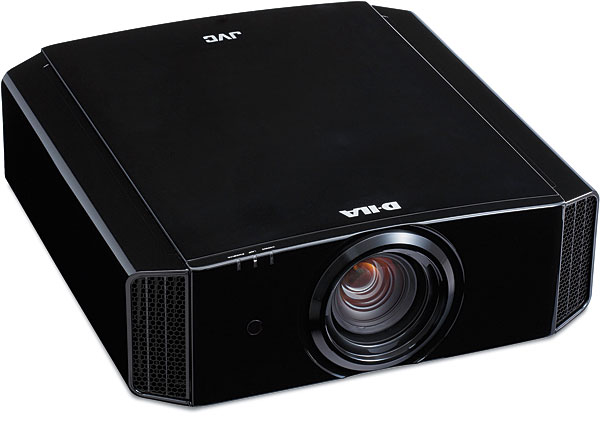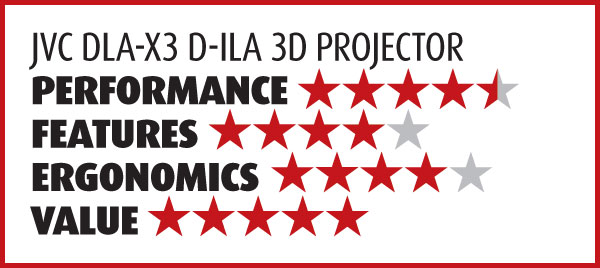JVC DLA-X3 D-ILA 3D Projector Page 3
With the DLA-X3 in High lamp mode and the iris all the way open, I estimate that the projector was managing about 3 to 4 ft-L through the glasses. While this is indeed dim, the image looked pretty good. It was easily as bright as anything I’ve seen in commercial cinema. While it’s obviously darker than the DLA-X3’s 2D playback, it wasn’t frustrating. Still, if 3D is going to be your preferred playback mode, I would investigate the different screens on the market. I have a 1.3-gain screen, but there are other options that offer far more gain that would allow for a brighter image for 3D use. These screens may present other compromises for 2D playback, so make sure you do your homework to get the screen that will be the best fit for your viewing tastes and environment.

Because the left- and right-eye images for 3D are slightly displaced, a slight image doubling may appear on some parts of the screen if one eye sees an image meant for the other. This artifact is called ghosting, and I haven’t seen a 3D system yet that’s totally immune to it. But the DLA-X3 did a fantastic job. The overall 3D performance seemed to improve when I gave the projector some warmup time (15 to 30 minutes) before I jumped into 3D playback. But with the 10 to 15 Blu-ray 3D titles I tried out, ghosting was rarely if ever an issue. The only problematic Blu-ray 3D title I encountered was Universal’s Despicable Me. For some reason, ghosting was an ongoing issue with this disc. We had the chance to compare the performance of the DLA-X7 with the DLA-X3 on this title, and the DLA-X7 didn’t show the ghosting artifacts that the DLA-X3 did. Keep in mind that the DLA-X7 retails for almost twice the price of the DLA-X3, and it’s also THX 3D certified. I didn’t have any issues with the other titles I viewed, including the popular (and Panasonic exclusive) Avatar, Shrek Forever After (Samsung exclusive), and How to Train Your Dragon.
As we move into the new wave of 3D, one of my biggest concerns with displays is how they will handle 2D. Since display manufacturers are spending more time getting 3D up and going, I was worried that there would be no improvements in 2D playback, or even worse, that compromises would need to be made with 2D performance to help with the 3D. Fortunately, that simply wasn’t the case. With 2D playback, the DLA-X3 was one of the best projectors I’ve ever used.
As I mentioned, before the DLA-X3 was in my room, I had a JVC DLA-RS35. This was JVC’s previous flagship projector with handpicked parts. While the DLA-RS35 had slightly better pixel focus and convergence, it also had its share of minor motion artifacts that manifested as slight contouring with some motion and panning. JVC seems to have resolved this issue in the DLA-X3; I didn’t see it at all in normal viewing. One of the best scenes to view this artifact is in Cars when the fireworks go off over the stadium and the camera pans down. There are some stadium lights that always showed obvious banding with previous JVC models, but that artifact is completely gone with the new design. The only downside I saw was some minor noise that appeared in gray ramps and color bars. This was pretty obvious with test patterns, but I couldn’t see it with real-world material. I would guess this is a dithering issue that’s related to whatever JVC is doing to eliminate the motion artifacts, but it’s hard to say. It certainly didn’t affect normal viewing with either 2D or 3D playback.
JVC has also added some new features for motion handling. The last generation featured some 120-hertz motion-interpolation features that I wasn’t a big fan of. Essentially, motion interpolation produces fake frames to smooth out motion. This can eliminate some of the jerkiness associated with panning, especially with 24-fps sources like film. You see demonstrations of motion interpolation all the time in store flat-panel demos, as they almost all default to on. Manufacturers commonly refer to this feature as 120-Hz or 240-Hz mode. JVC calls its motion system Clear Motion Drive (CMD).
There are five CMD modes to choose from: Mode 1 (Dark Frame Insertion light), Mode 2 (Dark Frame Insertion heavy), Mode 3 (Interpolation light), Mode 4 (Interpolation heavy), and Inverse Telecine. Modes 1 and 2 are new to the D-ILA platform. Dark frame insertion essentially inserts dark frames into the signal path. This can have a subtle effect on motion, but it’s also supposed to ease eyestrain with brighter images. I found Modes 1 and 2 to be far more agreeable than the Interpolation modes, as they didn’t seem to add a lot of fake frames, and motion looked very natural. With 1080p/24 sources such as Blu-ray, I didn’t notice any difference with CMD turned on. With 1080p/60 sources, the effect was a bit more noticeable, with slightly better resolution in motion.
Clear Motion Drive Modes 3 and 4 are a completely different animal. Both smooth out motion substantially and give film material a video look that reminds me of daytime television shows. The inserted frames give the image a bit more dimension and detail, but they also impart a bizarre signature to motion that completely eliminates the film look that I love so much. There’s a CMD demo mode that uses a split screen to let you compare content with the feature on and off. I recommend that you leave this feature off for movie playback, but I know people who like the look despite its inherent issues.
The Inverse Telecine mode is for interlaced material (e.g., 1080i) or 60-fps material (e.g., 1080p). This mode looks at the material’s cadence and converts it to 24p playback like you get from Blu-ray Discs. This helps eliminate judder, an artifact that can occur when you play back a 24-fps source such as film at 60 fps. The JVC did an effective job with the test clips I had on hand, but there were some minor ghosting artifacts with fast motion. As I recommend with all motion modes, experiment with different material and find out what you like. Everyone has different opinions when it comes to motion handling.
Contrast is in line with JVC’s previous projectors. JVC claims a 50,000:1 contrast ratio, but with the DLA-X3 calibrated to D65, the best contrast we could measure was about 28,000:1 with the iris fully closed and the projector at its longest throw. I had the DLA-X3 set up to achieve about 13 ft-L on the screen, and I was getting about 20,000:1. This resulted in great shadow detail and deep blacks. Like every projector I’ve had before, I’d love to see a darker black floor, but it was certainly satisfying with all the material I watched. I didn’t have the chance to measure the projector’s ANSI contrast performance, but I noticed a subtle improvement over my DLA-RS35. The DLA-X3 was more in line with the performance I’m used to from the higher-end DLP projectors in this regard, although it’s still slightly short of the DLP reference designs.
When I looked at some of my favorite Blu-ray demo material, I saw beautiful detail with plenty of contrast and depth. My go-to disc for shadow detail, depth, and dimension is The International. This Blu-ray features razor-sharp imagery that’s second to none on the format and will really show how good a display can be. The DLA-X3 excelled, with fine object detail, superb shadow detail, and first-class definition. Another huge highlight was David Fincher’s recent effort, The Social Network. This film was captured with the latest 4k digital cameras and has a very dark and moody image. The DLA-X3 rendered breathtaking detail with incredible depth.
For animation, I always love throwing on Cars, as the color palette and superbly detailed rendering produce the finest animation I’ve seen on Blu-ray yet. Again, the DLA-X3 performed flawlessly and never left me wanting my old reference DLA-RS35. Another favorite is DreamWorks Animation’s Kung Fu Panda. The dimension and detail in this film are nearly second to none. The DLA-X3 rendered the fine object detail with aplomb, and color rendition was incredible.
Conclusion
In the DLA-X3, it is truly amazing that JVC has been able to improve on their 2D performance and deliver exceptional 3D performance with their freshman effort, all at a price of $4,495. Just a few short years ago, this level of 2D performance wasn’t possible for less than $10,000, and I never dreamed that you’d be able to get into 3D near this price point—especially with this level of performance. The biggest issue JVC faces with the DLA-X3 is justifying the price difference between it and the next level up, the DLA-X7, which is nearly twice the cost. The DLA-X3 throws an incredible image and needs little tweaking to make the most of its performance. Value has simply never looked so good.





























































